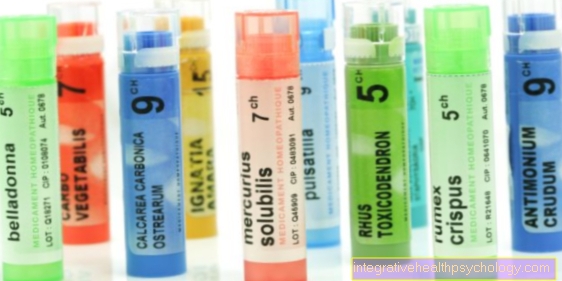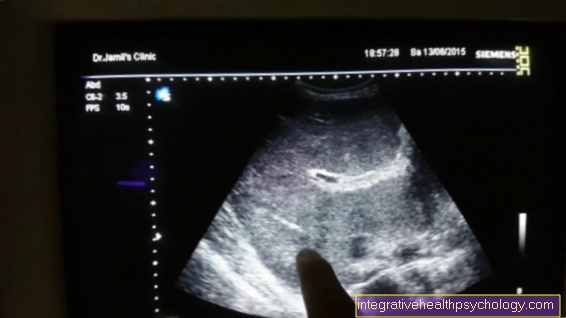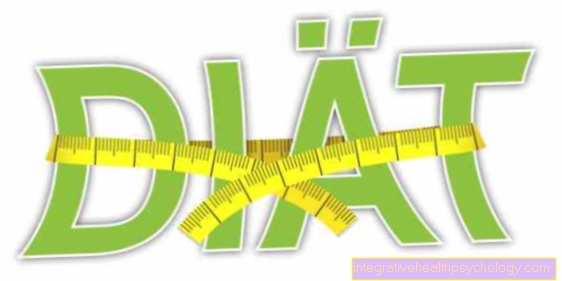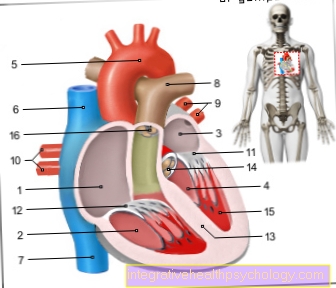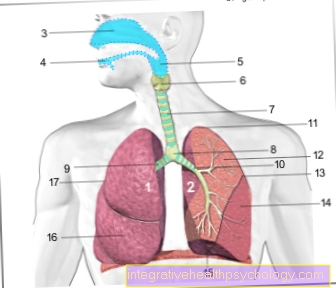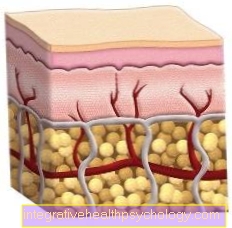Cortisone therapy for asthma
introduction
Along with beta-2 sympathomimetics, glucocorticoids (cortisone) are the most important group of drugs in the treatment of chronic inflammatory lung diseases such as bronchial asthma or COPD (Chronic obstructive pulmonary disease).
Used as a breath spray or powder, they get directly into the lungs and bronchi. There, glucocorticoids control the development of inflammation in the lining of the lungs. In the long term, they alleviate the overreactivity of the lung tissue and reduce the frequency of respiratory distress attacks (asthma attacks). Inhaled glucocorticoids, however, are not drugs for acute emergencies; they are only effective as part of long-term therapy.
Read more on the topic Asthma attack

effect
Inhaled glucocorticoids (cortisone, cortisol) act on the bronchial mucosa. There they inhibit the development of inflammation by suppressing the release of the body's own substances that trigger an inflammatory reaction (see review article cortisone). They also reduce the swelling of the mucous membranes and the formation of tough mucus.
It is very important that the glucocorticoids are inhaled regularly; even in phases when no symptoms occur. The success of asthma therapy with glucocorticoids can be seen in the long term. Only if inflammation of the bronchial mucosa is prevented in the long term will the hypersensitivity and the probability of breathlessness attacks improve. After a week at the latest, there should be a clear improvement in the symptoms.
This article might also interest you: Emergency spray for asthma
When do you need cortisone for asthma?
Asthma therapy is divided into 5 stages. From level 2, cortisone sprays, i.e. inhaled corticosteroids (ICS), are used. In stage 2, the use of inhaled corticosteroids in low doses is recommended. In level 3, medium-dose ICS are recommended; from level 4, medium to high-dose ICS are recommended. In stage 5, the systemic - i.e. oral or intravenous - use of cortisone preparations may be necessary. However, this is extremely rarely the case. Cortisone does not act as an immediate remedy in asthma but has a long-term effect: It has an anti-inflammatory effect on the hyperreactive bronchial mucosa and thus counteracts the recurring inflammatory reactions in the respiratory tract in the long term. Inhaled corticosteroids are therefore not only taken when needed but always permanently and regularly.
Long term therapy
The diagnosis of asthma is usually combined with long-term therapy, depending on the severity. Many patients fear long-term use of Cortisone supplements. However, today there are modern drugs available that reduce the risk of side effects common to cortisone occur, have drastically minimized.
Glucocorticoids, which are prescribed for asthma, are used almost exclusively by inhalation. Only in very severe cases or in extremely inflamed and mucous bronchitreatment is temporarily given in tablet form. When inhaled, the active ingredient gets deep into the lungs. Modern glucocorticoids form a deposit in the tissue there. This means that the active ingredient is only slowly distributed from the lungs to the rest of the body and reduces the risk of undesirable side effects.
Cortisone shock therapy
With cortisone shock therapy, very high doses of cortisone are used for a short period of time in the acute phase of an illness in order to achieve rapid relief of the symptoms. The dose of cortisone is then reduced relatively quickly to a dose that roughly corresponds to the Cushing threshold. Such a cortisone surge therapy usually leads to a relatively quick therapeutic success. In bronchial asthma, cortisone shock therapy plays only a very minor role. If at all, it is only used in stage 5 of asthma therapy if all other measures have not achieved sufficient symptom relief.
What is the difference between tablets and sprays containing cortisone?
Since the bronchial tubes, i.e. part of the airways, are affected in asthma, cortisone preparations are almost exclusively used inhalatively, i.e. as a spray, in the disease. Cortisone preparations can only be taken in tablet form in level 5, i.e. the maximum level of asthma therapy, if all other measures do not achieve adequate asthma control. The effect is similar, the cortisone preparations are anti-inflammatory both inhalatively and in tablet form.
While the spray mainly acts on the bronchial mucosa due to the type of application, the tablets work throughout the body. This is undesirable and increases the risk of numerous side effects and Cushing's disease. In the vast majority of cases, therefore, inhalative cortisone therapy is preferable to therapy with tablets in bronchial asthma.
- Cortisone spray
- Cortisone tablet
Side effects
Used properly at the recommended doses, inhalation (inhaled) administered glucocorticoids (cortisone) rarely systemic side effects and hardly any influence on the body's own cortisone production. However, local side effects such as dry mouth, hoarseness, difficulty swallowing and sore throat may occur under certain circumstances.
In connection with inhaled glucocorticoid therapy, fungal infections in the oropharynx are more common. After use, residues of the active ingredient remain in the oropharynx and thus promote such infections. Should a fungal infection nevertheless occur, this can usually be treated very effectively with antimycotics (drugs against fungi, e.g. nystatin).
The swallowing of remaining active substance residues in the oropharynx is not a cause for concern. Glucocorticoids intended for inhalation are inactivated and excreted in the digestive tract. With long-term use of inhalable glucocorticoids, the likelihood of systemic side effects is much lower than with the ingestion of cortisone tablets. However, there is always a residual risk. It is therefore advisable to check the growth of children who are dependent on long-term use of cortisone sprays. Women after the menopause should have their bone density (see osteoporosis) checked at intervals.
A fungal infection in the oropharynx can, however, be effectively prevented by inhaling your medication immediately before eating or rinsing your mouth or brushing your teeth after taking it.
What is the Cushing Threshold?
The Cushing threshold is understood to be the maximum dose of cortisone preparations that can still be taken daily without the risk of developing what is known as Cushing's syndrome. In the case of long-term high-dose therapy with cortisone preparations, there is a risk that the excess supply of cortisol will lead to so-called Cushing's syndrome, which can be accompanied by numerous symptoms. These include:
- Redistribution of body fat with trunk obesity, bull neck and full moon face
- Reduced growth (in childhood)
- increased risk of developing diabetes mellitus and high blood pressure
- Skin symptoms such as thinning of the skin, red streaks of the skin (Striae distensae) and acne
- Disorders of the sexual function and hormonal balance with menstrual disorders or lack of menstruation in women
- Muscle weakness
- Osteoporosis with an increased risk of fractures
- Suppression of the immune system with increased susceptibility to infection
- depressions
In order to avoid the development of such a Cushing's syndrome, a certain dose of cortisone per day should not be exceeded during long-term therapy with cortisone preparations. This dose is different for each preparation. Plus, it's just a rough guide. When using cortisone by inhalation, as occurs in most cases in bronchial asthma, the risk of developing iatrogenic Cushing's syndrome is lower than with long-term oral or intravenous use of cortisone. Therefore, and because of the rather low dose which is inhaled in bronchial asthma, the Cushing threshold plays only a subordinate role in asthma therapy.
Inhalation systems
MDIs
In the case of metered dose inhalers, the active ingredient is in dissolved form in a pressure-resistant aluminum cartridge. A CFC-free propellant is used as the solvent. Propellant gases can be liquefied under pressure so that the active ingredient (Cortisone) can solve. Some preparations have an additional liquid added to the liquid propellant phase.
When a spray is triggered, a defined amount of active ingredient is sprayed out. The propellant gas evaporates suddenly and the active ingredient is released as very fine droplets and is sucked in through inhalation.
There are different manufacturers with different cortisone combinations. The Symbicort metered dose inhaler contains e.g. Cortisone.
For more information, see:
- Symbicort®
- Pulmicort®
Use of metered dose inhalers
When using a metered dose inhaler, you should inhale deeply at the same time as you release the spray, hold your breath for 5 - 10 seconds with your mouth closed so that the active ingredient can settle in the lungs. Then slowly exhale through your nose again.
This application technique requires some practice and is particularly difficult for children and elderly patients. So-called spacers can be used to facilitate this application of metered dose inhalers. These are special ballast chambers that are placed between the mouthpiece and the cartridge. With one burst of spray, the chamber fills with a fine spray of the active ingredient, which can then be inhaled with a deep breath. But here too, after inhaling, hold your breath for at least 5 seconds, then exhale through your nose. If you need to reapply, wait at least 1 minute.
Furthermore, in addition to propellant-mediated systems, such as metered dose aerosols, so-called "breath triggered systems". With them, as the name suggests, the active ingredient is released from the inhaler by the force of a breath. They have the advantage that application problems, such as the coordination between inhalation and triggering the spray, are eliminated. These inhalation systems triggered by a breath can contain the active ingredient as a solution and release it as a spray. They are i.a. on the market under the names Easybreathe® and Autohaler®.
The active ingredient can also be inhaled as a powder. With the breath, the active ingredient is broken up into the finest powder particles and reaches the lungs. The harder you inhale, the finer the powder becomes. Here, too, hold your breath briefly after inhaling so that the active ingredient can settle in the lungs. Powder inhalers can contain the active ingredient either as a reservoir (collecting container) or as individually packaged doses. The former are relatively sensitive to moisture. The devices in question should therefore always be stored tightly closed. In addition, it should be avoided to breathe out back into the inhalers, otherwise the powder could clump together. Powder inhalation systems with reservoirs include Easyhaler®, Jethaler®, Novolizer® and Turbohaler®. The latest addition to powder inhalers is the Diskus®. It has a low internal resistance, making it easier to breathe in. In addition, it is insensitive to moisture, as the dosages are individually welded.
Nebulizer
Nebulizers are electronically operated inhalation systems. In the case of nebulizers, the active ingredient is in the form of a solution that is released as very fine droplets / mist when the device is operated. The release takes place relatively slowly compared to the dosage forms described above, so that you can take more time to inhale.
How often should you use inhalers?
Glucocorticoids are not drugs for acute attacks, but are intended for long-term therapy!
For the long-term success of the therapy, it is therefore important to use the prescribed preparation regularly - even if there are currently no symptoms. Depending on the severity of the disease, inhalation takes place once or twice a day. The entire daily dose can also be taken all at once. Whether in the morning or in the evening is arbitrary.
Your doctor will prescribe higher dosages when you start cortisone therapy. As soon as the effects set in and the symptoms subside, your doctor will reduce the dose. It should be so low that your symptoms can be easily controlled. It can help if you keep an asthma diary in which you record your current state of health and the dose used. In this way, your doctor can work with you to find the optimal dosage.
What are the alternatives to cortisone?
The cortisone preparations most frequently used in asthma therapy are budenoside and beclomethasone. In addition to these cortisone preparations, beta-2 sympathomimetics play a particularly important role in asthma therapy. However, their effect differs significantly from the cortisone preparations mentioned.
While the inhaled cortisosteroids have a long-term anti-inflammatory effect in asthma, beta-2 sympathomimetics work by widening the airways for a short or long term. Short-acting beta-2 sympathomimetics such as salbutamol are used in acute asthma attacks because they lead to an almost immediate relief of shortness of breath by widening the airways. Inhaled cortisone preparations are therefore not really comparable with the beta-2 sympathomimetics. From stage 2 of asthma therapy, both substances play an important and equal role in asthma therapy.
Read about this: Emergency spray for asthma




